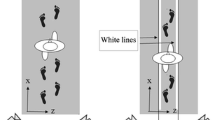Abstract
Cerebellar ataxia is associated with unsteady, stumbling gait, and affected patients report a high rate of falls, particularly during locomotor tasks. U-turns (180° turns while walking) require a high level of coordination in order to completely reverse the body trajectory during ongoing motion, and they are particularly challenging for patients with cerebellar ataxia. The aim of this study was to investigate the kinematic strategies adopted by ataxic patients when performing U-turns. Nine ataxic patients and ten controls were analysed as they performed 180° turns to the right while walking. We evaluated the following aspects: centre of mass velocity, body rotation, number of steps needed to complete the task, step length and step width, lower limb joint kinematics and segmental reorientation. Compared with controls, the ataxic patients showed slower deceleration and re-acceleration of the body, needed more steps to complete the U-turn, showed markedly reduced step length and were unable to modulate step width between steps. Furthermore, the patients adopted an extended joint rather than a flexed joint turning strategy, and the degree of knee flexion was found to be negatively correlated with the number of falls. Ataxic patients show an abnormal U-turn in comparison to age-matched healthy subjects. Some of the observed alterations are indicative of a primary deficit in limb-joint coordination, whereas others suggest that patients choose a compensatory strategy aimed at reducing the instability.






Similar content being viewed by others
References
Palliyath S, Hallett M, Thomas SL, Lebiedowska MK. Gait in patients with cerebellar ataxia. Mov Disord. 1998;13(6):958–64.
Serrao M, Pierelli F, Ranavolo A, Draicchio F, Conte C, Don R, et al. Gait pattern in inherited cerebellar ataxias. Cerebellum. 2012;11(1):194–211.
van de Warrenburg BP, Steijns JA, Munneke M, Kremer BP, Bloem BR. Falls in degenerative cerebellar ataxias. Mov Disord. 2005;20(4):497–500.
Mari S, Serrao M, Casali C, Conte C, Ranavolo A, Padua L, et al. Turning strategies in patients with cerebellar ataxia. Exp Brain Res. 2012. doi:10.1007/s00221-012-3197-2.
Conte C, Serrao M, Casali C, Ranavolo A, Mari S, Draicchio F, et al. Planned gait termination in cerebellar ataxias. Cerebellum. 2012. doi:10.1007/s12311-011-0348-0.
Meinhart-Shibata P, Kramer M, Ashton-Miller JA, Persad C. Kinematic analyses of the 180 degrees standing turn: effects of age on strategies adopted by healthy young and older women. Gait Posture. 2005;22(2):119–25.
Glaister BC, Bernatz GC, Klute GK, Orendurff MS. Video task analysis of turning during activities of daily living. Gait Posture. 2007;25(2):289–94.
Hong M, Earhart GM. Effects of medication on turning deficits in individuals with Parkinson's disease. J Neurol Phys Ther. 2010;34(1):11–6.
Trouillas P, Takayanagi T, Hallett M, Currier RD, Subramony SH, Wessel K, et al. International Cooperative Ataxia Rating Scale for pharmacological assessment of the cerebellar syndrome. The Ataxia Neuropharmacology Committee of the World Federation of Neurology. J Neurol Sci. 1997;145(2):205–11.
Davis RB, Ounpuu S, Tyburski D, Gage JR. A gait analysis data collection and reduction technique. Hum Mov Sci. 1991;10:575–87.
Gutierrez-Farewik EM, Bartonek A, Saraste H. Comparison and evaluation of two common methods to measure center of mass displacement in three dimensions during gait. Hum Mov Sci. 2006;25(2):238–56.
Winter DA. Biomechanics of human movement. New York: Wiley; 1979.
Huxham F, Gong J, Baker R, Morris M, Iansek R. Defining spatial parameters for non-linear walking. Gait Posture. 2006;23(2):159–63.
Mak MK, Patla A, Hui-Chan C. Sudden turn during walking is impaired in people with Parkinson's disease. Exp Brain Res. 2008;190(1):43–51.
Vaughan CL, Davis BL, O’Connor JC. Dynamics of human gait. Cape Town: Kiboho (2nd Edition) 1999.
Greenhouse SW, Geisser S. On methods in the analysis of profile data. Psychometrika. 1959;24:95–112.
Taylor MJ, Dabnichki P, Strike SC. A three-dimensional biomechanical comparison between turning strategies during the stance phase of walking. Hum Mov Sci. 2005;24(4):558–73.
Hase K, Stein RB. Turning strategies during human walking. J Neurophysiol. 1999;81:2914–22.
Hase K, Stein RB. Analysis of rapid stopping during human walking. J Neurophysiol. 1998;80(1):255–61.
Bastian AJ. Mechanisms of ataxia. Phys Ther. 1997;77(6):672–5.
Acknowledgments
We thank Mrs. Catherine Wrenn for the English revision.
Conflict of Interest
Authors declare no conflict of interest or financial interests.
Author information
Authors and Affiliations
Corresponding author
Additional information
Mariano Serrao and Silvia Mari contributed equally to this work.
Rights and permissions
About this article
Cite this article
Serrao, M., Mari, S., Conte, C. et al. Strategies Adopted by Cerebellar Ataxia Patients to Perform U-Turns. Cerebellum 12, 460–468 (2013). https://doi.org/10.1007/s12311-012-0441-z
Published:
Issue Date:
DOI: https://doi.org/10.1007/s12311-012-0441-z




